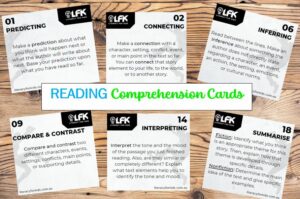Gearing up for Term 4: How to Maximise Student Engagement

The end of the school year is approaching and it can be a tough time where some students may be starting to mentally check out. How do you manage the engagement dip, especially for older learners in the Year 7 – 9 age bracket?
This decline, where students become increasingly distracted or disengaged, poses a significant concern for educators due to its potential to impact both academic achievement and classroom behaviour negatively. Today’s article will provide teachers, parents, and students with concrete advice and tips on how to wrap up the semester successfully, in terms of marks and mental state.
1) Encourage self-reflection
Remind your students (or child) of what they have achieved so far this year. Create self-reflection tasks to allow them the opportunity to track their growth. What new skills have they gained this year? How can you practice these in term 4?
NOTE: Don’t dismiss any anxieties or fears about Term 4. It’s important to acknowledge these feelings and make a plan (some tips below might help!).

2) Make a schedule
Students should create a study schedule and display it prominently. Encourage students to try their best to stick to it in order to stay focussed and avoid procrastination. Ensure that it is balanced to leave time for relaxation.
3) Model enthusiasm for learning!
One of the best ways to get your students motivated is to share your enthusiasm. When you’re excited about teaching, they’ll be much more excited about learning. It’s that simple.
4) Getting our kids to ‘care’ about their learning
Those who care about their learning tend to study more deeply. If they earned a disappointing grade or mark on their first test (or second), they try to do everything in their power to recover. Examples include asking for teacher feedback, going over their tests, asking other students for help, analysing the marking criteria. As a result of student focus on their learning, those who possess a growth mindset recover from their earlier stumbles.
Recently, one of our own children failed a test miserably, but the school helped us (& her) to see it as a checkpoint for the concepts that she didn’t understand or ‘get’. It was a great lesson in managing failure into a different mindset to improve.
5) Harness student interests
Knowing your students also has some other benefits, namely that it allows you to relate classroom material to things that students are interested in or have experienced during the year. Teachers can use these interests to make things more interesting and relatable to students, keeping students motivated for longer. Parents should communicate with teachers if something special has happened at home that their child might want to share with the class.
6) Offer rewards
Everyone likes positive reinforcement, and offering your students the chance to earn them is an excellent motivator. Things like pizza parties, watching movies, or even something as simple as a sticker on an assignment can make students work harder and really aim to achieve. Consider the personalities and needs of your students to determine appropriate rewards for your class. At home, parents might negotiate a meal with their friends, telling another adult about their achievement while their child is listening, reward vouchers.
7) The ‘Storm and Stress’ of Adolescence
Hormonal changes during adolescence significantly influence students’ moods and decision-making skills. Social dynamics also evolve, with peer groups becoming more prominent, often pulling attention away from academics. Additionally, students tend to view these middle years as less critical—Year 7 is heavily supported as they transition from primary school, while Year 10 shifts focus to selecting subjects for their final years.
Read this article about several factors that contribute to this dip and how to help this age group.
8) Embrace the future!
Repeated studies have found that students with a growth mindset do better academically (and enjoy it more). So encourage a growth mindset by highlighting that there are new challenges coming their way but they have the skills to tackle and embrace those challenges.
TIP: Consider asking your pupils (or child) to create a “vision board” for 2025 to help them focus on the prospects for next year.
Want your students to finish strong in their literacy? Want more from your literacy program? Contact us for a 30-day free trial in your school or classroom. New schools receive these great ‘Turn and Talk’ comprehension cards for their classroom ~

Student Comprehension Cards
Check out our blogs for more ideas and tips.
Speaking at Oxford, UK – our founder will be presenting research around boys’ literacy!
Five Game Changers for Successful Whole Class Literacy
Identify Comprehension Gaps with these great cards
Steps to Successfully Support Disengaged Learners
See us featured in The Educator Australia magazine
Research confirms that early reading boosts literacy
Boys Love LFB – Here’s what they have to say!
Get boys reading in the digital age
Why write? Tips for reluctant writers
Brought to you by Tanya Grambower

